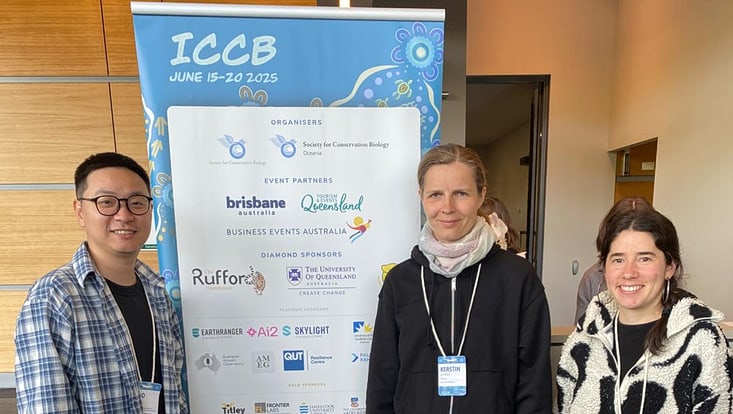FNK's contributions to advancing conservation science at the International Conference of Conservation Biology (ICCB)
30 June 2025

Photo: Nicole Acosta
Three members of FNK, Kerstin Jantke, Hao Xia, and Nicole Acosta presented their work at the International Conference of Conservation Biology (ICCB) 2025 held at Meanjin/Brisbane, Australia.
The ICCB 2025 brought together about 1500 leading scientists, conservation practitioners, and students from around the world to address pressing global biodiversity challenges. Organized by the Society for Conservation Biology, the conference served as a platform for sharing the latest research, innovative conservation strategies, and interdisciplinary approaches aimed at safeguarding the planet’s natural heritage.

Kerstin Jantke presented an assessment of how well protected area (PA) networks represent ecological diversity. Her work emphasized that while global conservation targets like the Aichi Target 11 and the Kunming-Montreal 30x30 target have led to an expansion of protected areas, simply increasing the proportion of protected land and sea does not guarantee effective conservation. She introduced a methodology using spatial analyses and the Mean Target Achievement metric to evaluate the actual ecological representation within PA networks. Her findings revealed that, despite the designation of 170,000 km² of terrestrial and 3 million km² of marine reserves between 2011 and 2020, about half of terrestrial and marine ecoregions in nine case study countries remained poorly protected as of 2020. This underscores the need for targeted action to ensure that ecological representation is prioritized in future PA expansions, particularly under the 30x30 target. Her methodology supports ongoing evaluation, gap identification, and monitoring, and is adaptable to various biodiversity surrogates, countries, and regions.
Hao Xia’s presentation analysed the effectiveness of PAs in safeguarding Arctic tundra biodiversity by assessing the distribution and coverage of 2,150 species across multiple taxa. Using spatial analysis and applying the Mean Target Achievement metric presented by Kerstin Jantke, Hao Xia quantified progress towards coverage and representation targets, revealing that although PA coverage in the Arctic tundra increased from 13% to 23.3% between 1990 and 2022, it still falls short of the 30% global target. The study found that 6.5% of species are not protected by any designated area, 78% have less than 30% of their range covered, and 87.5% are inadequately covered relative to their representation targets. By mapping the distributions of these “gap species” outside PAs, Hao Xia identified priority areas for future conservation action, highlighting the urgent need for more strategic planning to ensure adequate and representative protection of Arctic tundra species.


Nicole Acosta’s presentation addressed the intertwined challenges of invasive plant spread and food security on the Galapagos Islands, where declining agricultural activity has enabled invasive species to thrive in unmanaged farms and increased reliance on imported food heightens both food insecurity and biosecurity risks. Using a mathematical programming model, Nicole Acosta optimized land use to balance food self-sufficiency, local income, and minimization of invasive plant cover, while ensuring the protection of native vegetation. By simulating scenarios until year 2100, her analysis showed that increasing local food production can reduce invasive plant cover, food self-sufficiency can be met without disturbing remaining native vegetation in the rural area, and that meeting the micronutrient requirements for the population in year 2100 has a larger effect on land use distribution and invasive plant cover than other nutrient targets. Her findings offer practical insights for sustainable development and conservation strategies in Galapagos.
These presentations highlight FNK's contribution to advancing conservation science through innovative, data-driven approaches. From global protected area assessments to regional biodiversity planning and land-use optimization, their work underscores the importance of targeted, evidence-based strategies in achieving effective conservation outcomes.


